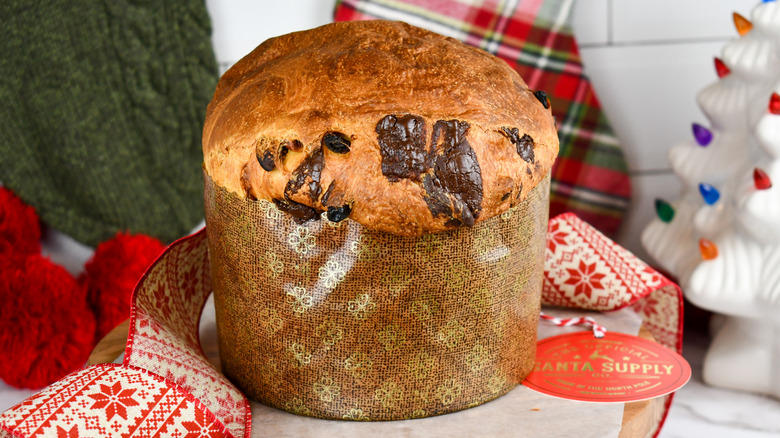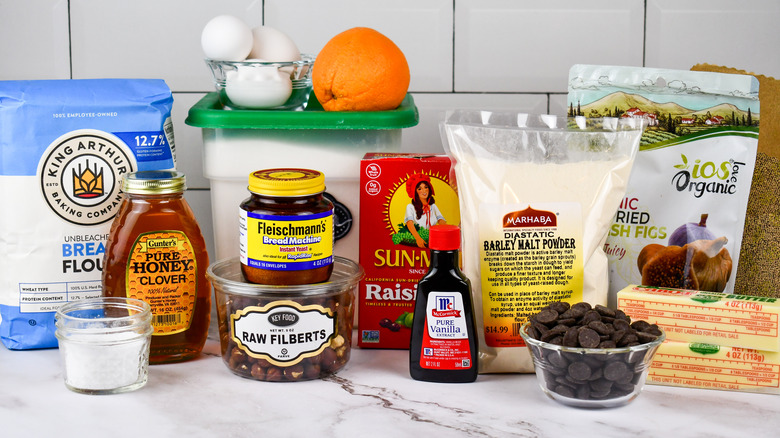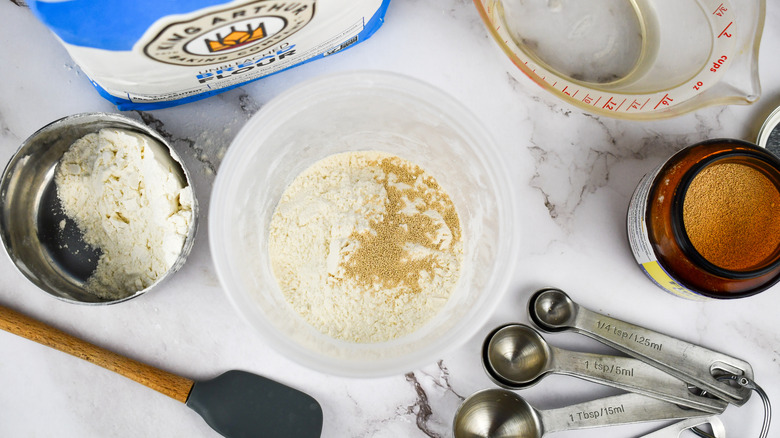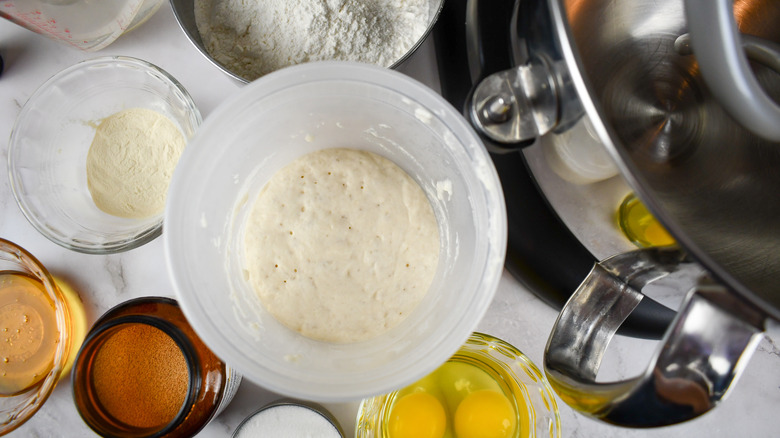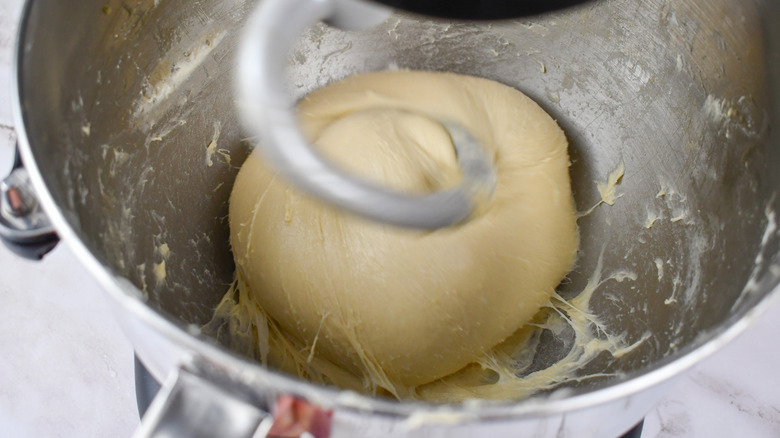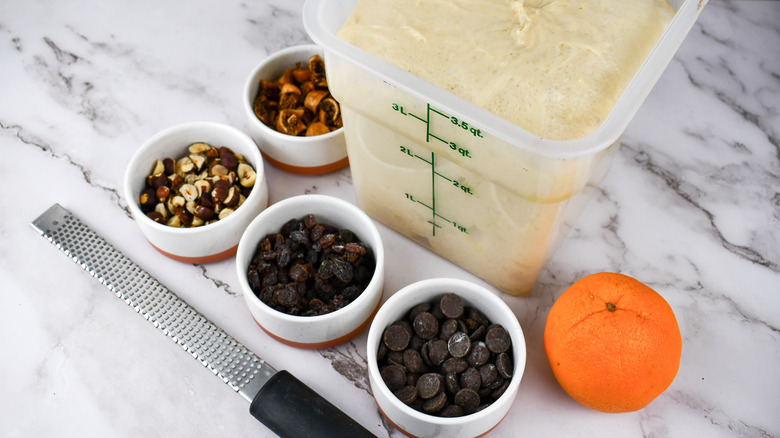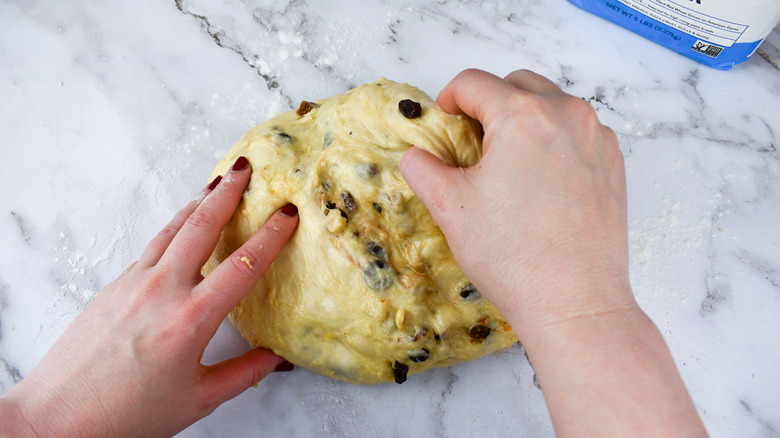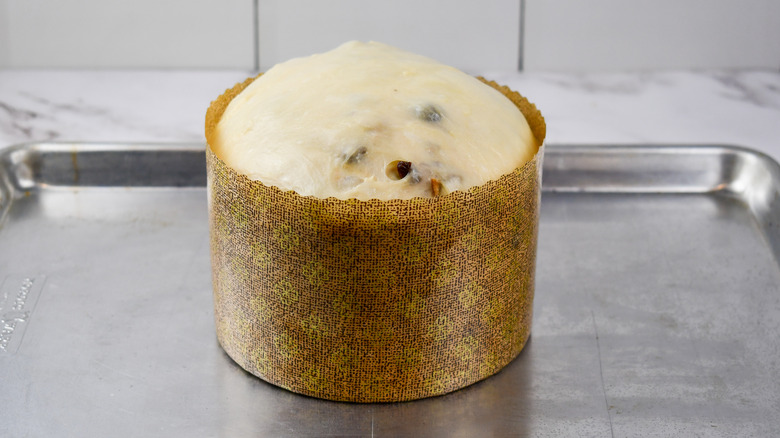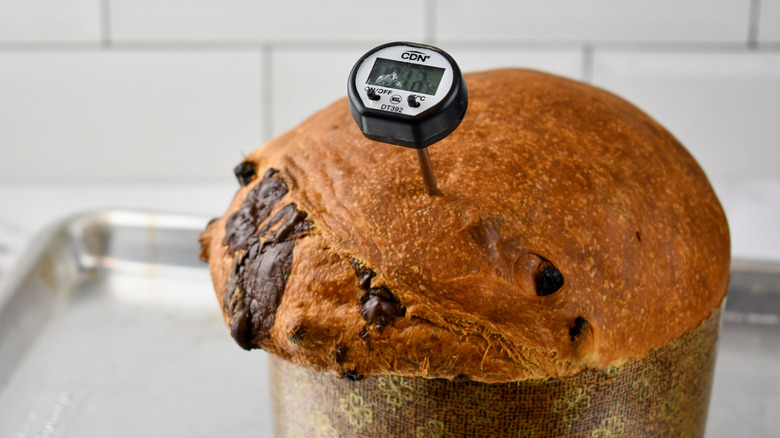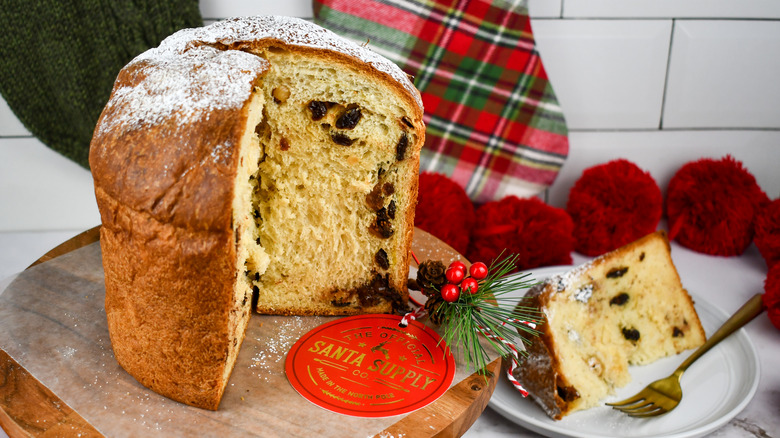Chocolate-Fig Holiday Panettone Recipe
Fruitcakes may be the popular traditional holiday treat in the U.S. and U.K., but in Italy, panettone is the traditional holiday pastry of choice. Instead of a cake, panettone is more of a yeasted bread, enriched with eggs, butter, and studded with a variety of dried fruit, nuts, and sometimes chocolate. The sweet bread is said to have originated in Milan, but can now be found all over Italy, as well as in bakeries and dessert shops around the world.
Typically, panettone takes 36 hours or more to create, depending on the type of starter the baker is using and how the dough develops. But this version, created by recipe developer Jenny Kellerhals of Feed Me Pastry, takes less time to make than traditional panettone, with all of the flavors and richness people love about the sweet bread. "I'm a big fan of panettone made with chocolate, so I've stuffed this version with bittersweet chocolate chips and paired them with sweet dried figs, toasty hazelnuts, raisins, and orange zest for an indulgent holiday treat," says Kellerhals. The mix-ins can be tailored to your tastes, and the finished product makes an impressive gift to friends and family this holiday season.
Gather the ingredients for the chocolate-fig panettone
Before you begin mixing your starter and dough, gather all of the ingredients you'll need in advance. For the starter, you'll need some bread flour, instant yeast, and a bit of lukewarm water. The water should be warm to the touch, but not hot or boiling.
Next, measure out the ingredients you'll need for the panettone dough, including some more lukewarm water, instant yeast, and bread flour, plus diastatic malt powder (more on that in a second), large eggs, sugar, honey, softened unsalted butter, vanilla extract, and kosher salt. For the mix-ins, Kellerhals uses chopped hazelnuts, raisins, chocolate chips, and an orange (specifically, the zest). As far as equipment, you'll want to use a large paper panettone mold, measuring about 6 inches in diameter, and 4 inches tall.
So, what is diastatic malt powder? It's a special ingredient that encourages your bread to rise higher, adds depth to the overall flavor, and helps develop a beautiful brown crust while baking. It can be easily found online or in specialty baking stores — as can paper panettone molds.
Mix the starter and let it rise
First, we need to make a quick starter, which will help kickstart the flavor development of your dough, and ultimately contribute to the final texture and color of the bread. "While this starter isn't aged as long as sourdough starters, for example, even giving your dough's yeast a few extra hours to develop adds depth to your final product," Kellerhals explains.
In a clear pint container or measuring cup, stir together the ingredients for the starter. Use a silicone spatula to scrape the bottom and sides of the container, making sure that all of the dry bits of flour and instant yeast are completely mixed in. Scrape down the sides of the container and clean any dough off the spatula back into the container. Take note where the beginning level of the starter is, so you know when it has doubled in size.
Cover the container with a lid or plastic wrap, and let the starter rise at room temperature until doubled in size, about an hour. For added flavor, you can prolong this step and let the starter rise in the refrigerator until doubled in size.
Begin mixing the panettone dough
The bulk of the panettone dough will mix in two stages. For the first stage, you'll empty all of the starter into the bowl of a stand mixer, followed by the water, yeast, bread flour, and diastatic malt powder. Attach the machine's dough hook and begin mixing on medium speed. The ingredients will be scrappy looking as you add in the eggs one at a time, followed by the sugar and honey.
Once all of these ingredients are in, turn the machine off and scrape down the sides of the bowl all the way to the bottom. Turn the mixer back on to medium-high, and knead until the dough forms a glutinous ball, and pulls away from the sides and bottom of the bowl, about 15 minutes.
Finish mixing the panettone dough
Once the dough has formed a ball, turn the mixing speed down to low, then add in the softened butter 1 tablespoon at a time. Add the vanilla extract and salt, then turn the mixer back up to medium-high. Continue kneading until all of the butter has been smoothly incorporated into the dough, and it once again pulls away from the sides and bottom of the bowl, about 10 minutes. Scrape down the bowl as necessary while mixing to encourage the butter to mix in.
Bulk ferment and prepare mix-ins
Spray a clear 1-gallon (or larger) container with cooking spray, and transfer the dough into it from the stand mixer bowl to bulk ferment. Cover the container with a lid or plastic wrap, and take note of the starting level of the dough. Allow the dough to rise at room temperature until tripled in volume, about 2 hours. While the dough rises, gather the mix-ins for the next step.
If you'd like to extend the dough's rise time to help develop more flavor, place the container in the refrigerator until the dough triples in volume. This stage can be done overnight.
Mix in fruit and chocolate, then shape the dough
To prepare the dough for its final rise, you'll need to add the mix-ins and shape the dough. First, gently tamp down the dough to deflate it. Then zest half of an orange directly into the container, and pour in the hazelnuts, figs, raisins, and chocolate chips. Grab one corner of the dough and pull it up and over the mix-ins, and tuck it in on the opposite side of the container. Repeat this motion, working your way around the container and folding the dough over itself.
Once the mix-ins are encapsulated in the dough and the gluten has become more elastic, turn the dough out onto a lightly floured surface. Continue to fold and gently knead the dough until all of the mix-ins have been incorporated, and form the dough into a ball. "The dough will still be soft, but when it's properly kneaded you'll notice that it's more elastic and able to hold a round shape without settling too quickly," says Kellerhals.
Proof the dough a final time
Lightly spray a paper panettone mold with cooking spray. Carefully drop the shaped dough into the paper mold, transfer the mold to a sheet tray, and cover the mold with lightly greased plastic wrap. Allow the dough to rise until it crests the edge of the mold, about an hour. While the dough rises, arrange your oven rack to the center position with plenty of space for the bread to rise. Preheat the oven to 400 F.
Bake the panettone
Once the dough has risen, place the sheet tray on the center oven rack and bake it at 400 F for 10 minutes. After 10 minutes, reduce the oven temperature to 350 F, and continue to bake for 40 more minutes. Rotate the pan about halfway through baking for even heat distribution and browning. The internal temperature of the bread will be 190 F when it's cooked all the way through. Cool the dough completely on a wire rack before serving, which could take several hours.
Slice and serve the chocolate-fig panettone
Once the chocolate-fig panettone is completely cool, it's ready to serve. A dusting of confectioner's sugar makes for a lovely presentation on either the entire loaf or the individual panettone slices. Leave the paper mold on the bread until you're ready to cut into it. It's easiest to cut the panettone in half or quarters with a serrated bread knife, then portion smaller slices off from there.
It almost goes without saying that a slice of panettone, like nearly all Italian desserts, pairs perfectly with an espresso or cappuccino, but feel free to enjoy it with any kind of coffee, tea, or warm beverage that you like most. We also like it with a glass of wine after dinner. Try smearing with butter, jam, or drizzled with honey for a little extra richness, or served with a scoop of your favorite gelato. This bread begins to dry out quickly after it's been cut, so make sure to wrap it tightly with plastic wrap if you want to save part of it after cutting into it. You can store it at room temperature for up to 2 days.

- For the starter
- ½ cup bread flour
- ¼ teaspoon instant yeast
- ⅓ cup lukewarm water
- For the panettone
- ½ cup lukewarm water
- 1 tablespoon instant yeast
- 2 ½ cups bread flour
- 1 tablespoon diastatic malt powder
- 2 eggs, large
- ⅓ cup sugar
- 2 ½ tablespoons honey
- 8 tablespoons (1 stick) unsalted butter, softened
- 1 teaspoon vanilla extract
- 1 teaspoon kosher salt
- 1 orange
- ½ cup finely diced dried candied figs
- ½ cup raisins
- ½ cup chopped toasted hazelnuts
- ½ cup bittersweet chocolate chips
- Powdered sugar, for serving
- Measure the bread flour, instant yeast, and water for the starter into a clear pint-sized container or measuring cup, and stir with a small silicone spatula. Make sure to incorporate all of the dry ingredients that may have stuck to the bottom of the container, and scrape down the sides. Note the beginning level of the starter, and cover the container with a lid or plastic wrap. Leave in a warm place to rise until doubled in size, about an hour.
- In the bowl of a stand mixer fitted with a dough hook, add the water, instant yeast, starter, bread flour, and diastatic malt powder. Begin mixing the dough on low speed, then add eggs one at a time. Add the sugar and honey, and then turn the mixing speed up to medium. Mix for 5 minutes, then scrape down the bowl. Continue to mix on medium-high (or as high as your machine will go without struggling), until the dough pulls away from the sides and bottom of the bowl.
- On low speed, add the softened butter, vanilla extract, and salt. Return to medium-high speed until all of the butter is completely mixed in, and the dough is once again pulling away from the sides of the bowl.
- Empty the dough into a clear, greased 1-gallon (or larger) container to bulk ferment. Cover with a lid or plastic wrap, note the starting volume, and allow the dough to rise in a warm place until tripled in volume, about 2 hours.
- Gently deflate the dough, zest half a large orange directly onto the dough, and add the figs, raisins, hazelnuts, and chocolate chips. Fold mix-ins into the dough by hand by pulling the dough up from the bottom of the container and folding it over the top. Continue folding in on each side until mix-ins are roughly incorporated.
- On a lightly floured surface, turn out the dough and continue to fold over itself, encapsulating all of the mix-ins and developing the gluten. Shape the dough into a loose boule, and drop it into a lightly greased paper panettone mold. Transfer the mold to a baking sheet. Cover with a greased piece of plastic wrap and let rise once more until the dough crests the top edge of the mold, about an hour. Center a rack in the oven and preheat to 400 F.
- Bake the panettone at 400 F for 10 minutes. Reduce the oven temperature to 350 F and bake for 20 minutes, before rotating the baking sheet. Bake for a final 20 minutes, then remove from the oven. The internal temperature of the dough should reach 190 F on an instant digital probe thermometer. Cool on a wire rack.
- Once completely cool, dust with powdered sugar (if using), slice, and serve.
Nutrition
| Calories per Serving | 404 |
| Total Fat | 17.2 g |
| Saturated Fat | 8.1 g |
| Trans Fat | 0.4 g |
| Cholesterol | 61.8 mg |
| Total Carbohydrates | 56.8 g |
| Dietary Fiber | 3.2 g |
| Total Sugars | 23.0 g |
| Sodium | 209.3 mg |
| Protein | 8.5 g |
